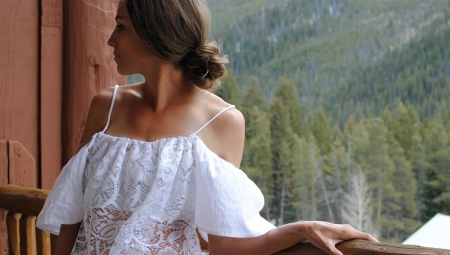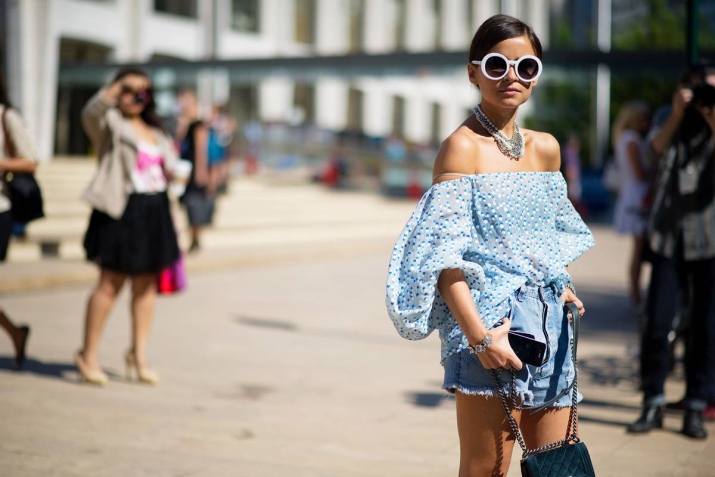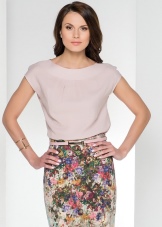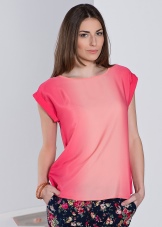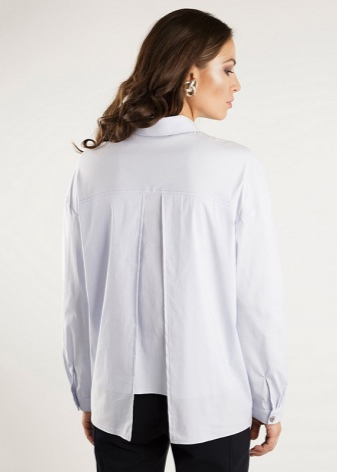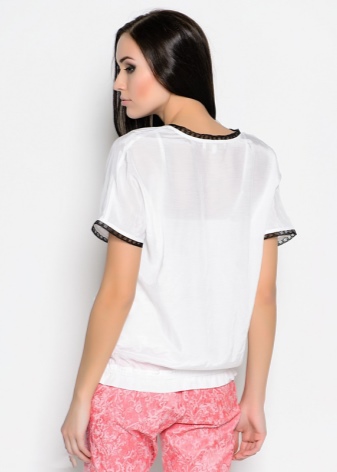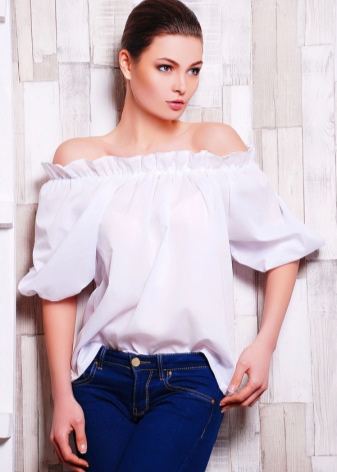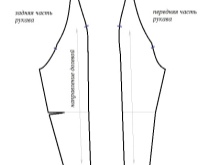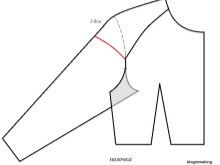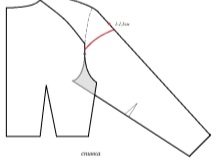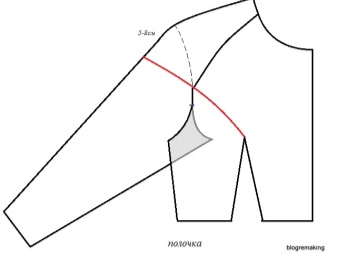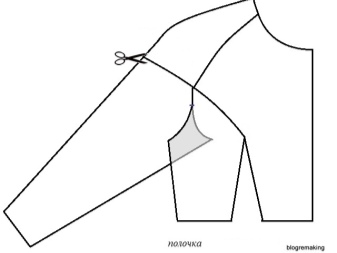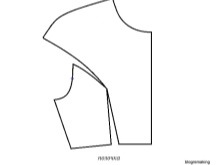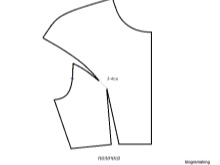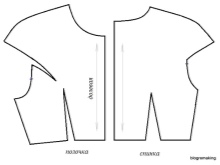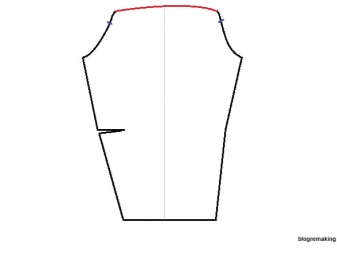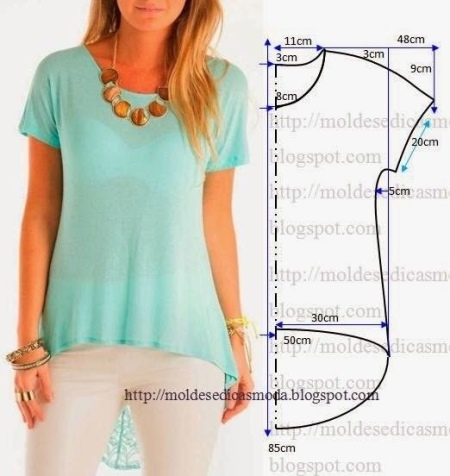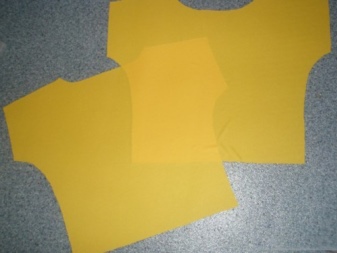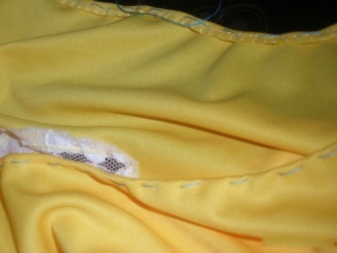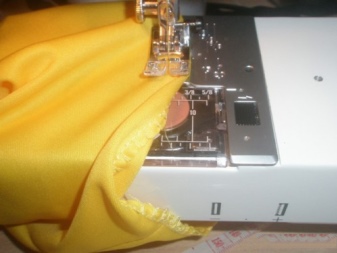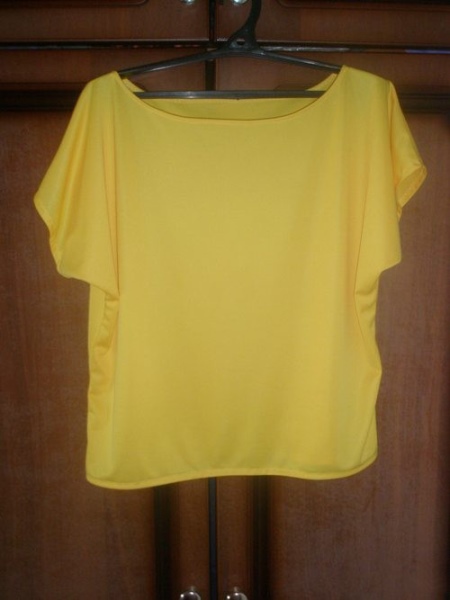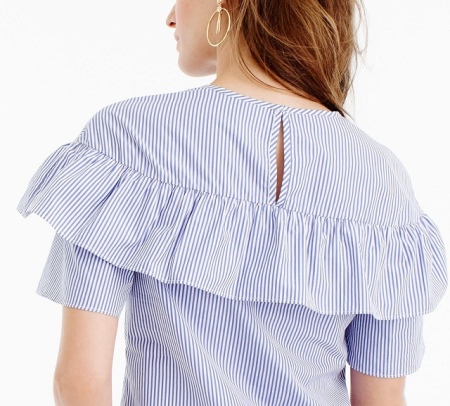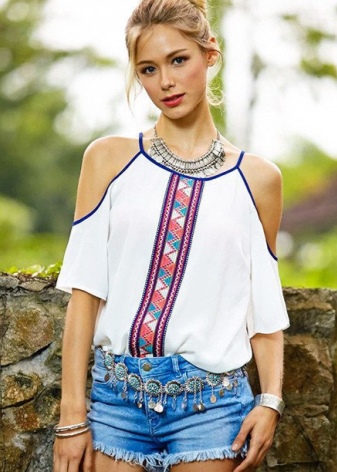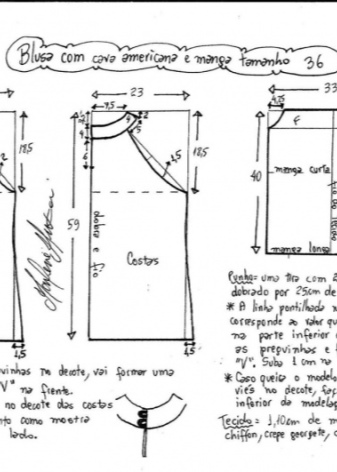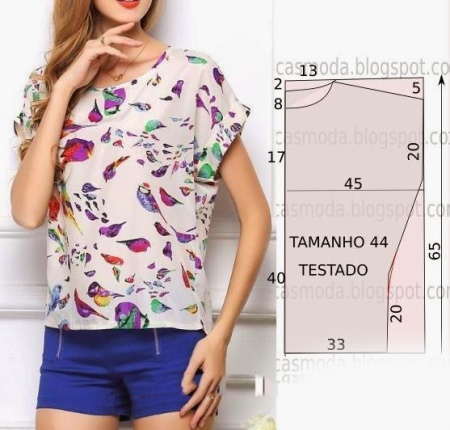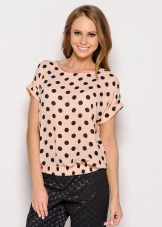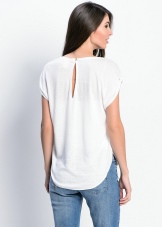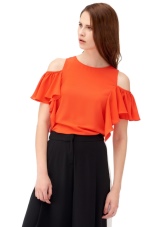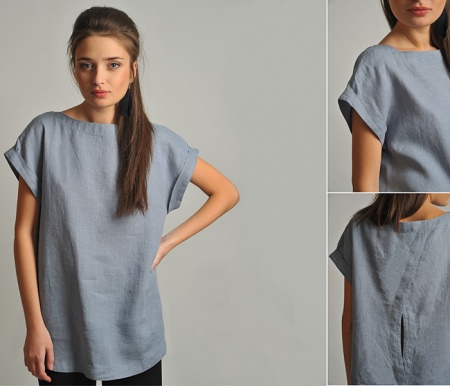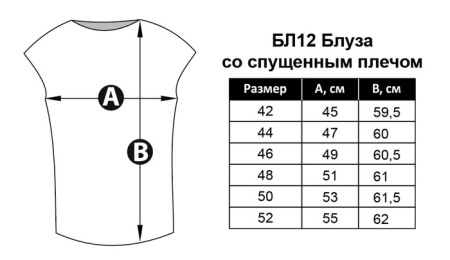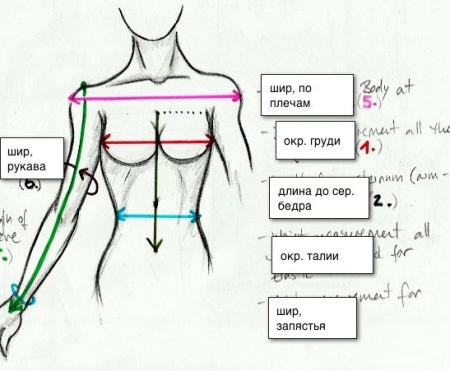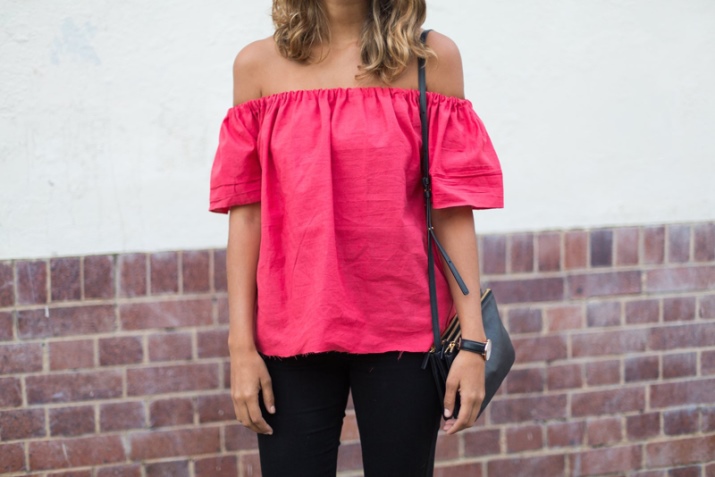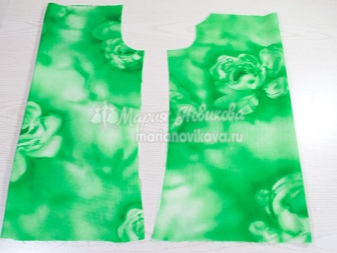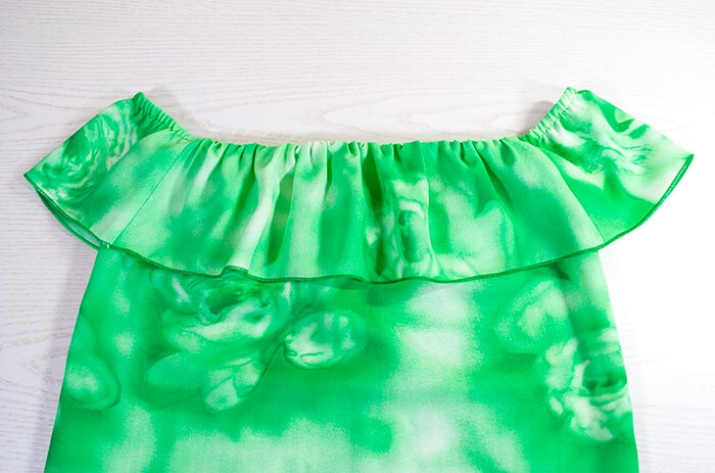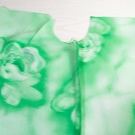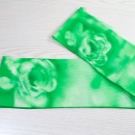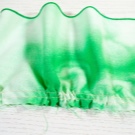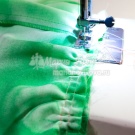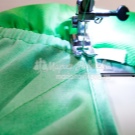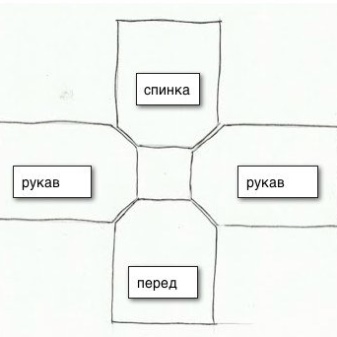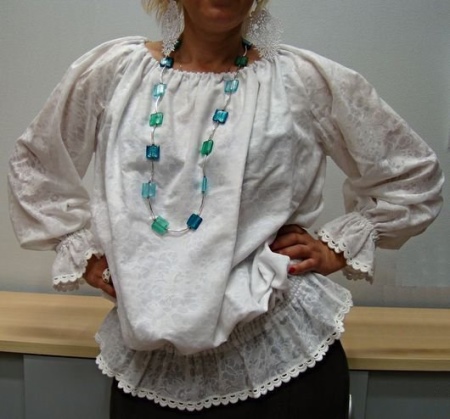Choosing clothes for the summer heat, I want to consider not only the factors of practicality and convenience, but also to remain feminine and delicate. In order not to lose softness and lightness in the image, you should opt for models of blouses with deflated sleeves and open shoulders, which will emphasize all the sophistication of female nature and will always make you feel comfortable.
Features and varieties of flat shoulder
The main feature of the lowered shoulder can be called an incredible femininity, intertwined with a light slovenliness. Models of the lowered shoulder, which do not open the shoulder completely, gently envelop it, lie down freely, opening the elegant clavicles.
Let us consider in more detail the types of blouses with a fully open shoulder, as well as other types that fit this category:
- The one-piece sleeve can also be classified as flat, which looks especially elegant when there is a “boat” neckline, the edges of which end at the shoulders, thanks to which the classical sleeve line shifts somewhat, slightly revealing the clavicle and the edge of the shoulder. Other options for neckline not change the fact that the sleeve is deflated, but affect the appearance of the product, giving it a more everyday, everyday look - in some cases, and festive, solemn - in others.
- A classic flat-type sewing sleeve is something unusual, since the sleeve line starts only from the middle of the shoulder, so that the blouse has a slightly offset armhole.
- A variety of deflated sleeves include models with open shoulders. A prominent representative of such products is a “peasant woman” blouse, the sleeve of which does not cover the shoulder, but begins only from the middle of the biceps.
A “peasant woman” can have a usual type of sleeve - long or short, loose or tight, or it can be somewhat non-standard - if a sufficiently long shuttlecock acts as a sleeve.
How to model?
If you undertake to sew a blouse with a lowered or open shoulders, you dream of coming up with something original, but you don’t know how to make your fantasies come true, you should initially make a standard pattern of a product with a short deflated sleeve.
After you make all the necessary measurements, it will be necessary to draw a pattern on special paper. It is necessary to draw only half of the product to make it more convenient in further work with it.
We take the details of the pattern, the basics of the bodice and raglan sleeves and join them along the armhole line.
We lower the shoulder line on the front by 5-8 cm, and on the back - by 1-1.5 cm more. Ie at 6-9 cm or 6.5-9.5 cm.
Cut out the details of the new lines.
The final version below.
At your discretion, the recess can be transferred to the manhole.
The two halves of the sleeves are joined along the upper cut and aligned with a smooth line.
Then the pattern will need to be cut and secured to the fabric, after folding the canvas in half. You should know that the inner edge of the pattern should be flush with the fold on the material.
It is necessary then to circle a special small pattern, then remove the paper part and carefully cut the resulting parts.
If you simply attach fabric details in the right places, you’ll get a stylish, but rustic blouse with a short sleeves down.
To make the product look more stylish and unusual, you can decorate it with a attached flounce, which is mounted a few centimeters below shoulder level and becomes the highlight of the product.
You can make large cuts on the shoulders using the following pattern.
Different variants of the same pattern
The classic blouse with a lowered shoulder has a fairly simple cut and is sewn from only two halves. But a simple product can be a bit boring, so the designers came up with many ways to decorate products, without changing the pattern.
The easiest way to decorate is to create decorative cutouts. Consider the most popular options:
- With a cut on the back - a classic pattern is complemented by a decorative cut in the center of the back, which will need to be processed, and the edges bend. Looks interesting, stylish and sexy;
- With cutouts on the sides - the model is suitable for those who are not afraid of candor. From the bottom edge upwards, cuts of necessary length are made on the sides. The edges are folded and processed. The model is suitable for skinny girls who are not afraid to expose some parts of their bodies.
- With a neckline front - a model that will look gorgeous on girls with big breasts. A simple cut in the neckline may look boring, so it is better to make it in the form of a drop, through which the outlines of seductive volumes are visible;
- With cutouts on the shoulders - the most simple in execution. It can be simple cuts, due to which the edges of the sleeves gracefully fall from the shoulders, or there can be a small cut through which the edge of the shoulder can be seen.
Thus, you can beautifully decorate the blouse with cuts, creating many variations, but using the base of the same pattern.
Sewing steps
It is not a secret for anyone that blouses with or without sleeves, however, like any other products, are sewn in several stages. None of them can be missed, since this can be serious for the finished product, it will quickly lose its original appearance and become useless.
So, let's take a closer look at each step of sewing a blouse and with their features.
Stage 1 - taking measurements
First of all, it is necessary to take measurements from the person for whom the blouse is sewn.
The following parameters should be measured:
- Throat circumference - in case the product has a high neck;
- Shoulder width;
- Arm circumference in the biceps area - in case the product has a standard sleeve;
- Chest girth;
- Waist circumference - you may need to make a tight model;
- Girth hips - in case the blouse has an elongated style.
Stage 2 - building patterns
Then, you need to make a pattern. If you consider yourself to be a novice and have not yet “got a hand” in sewing, it is recommended to first mark the details on thin paper specially designed for patterns.
It is worth paying special attention to the process, not forgetting the seam allowances.
After marking, it is necessary to cut out these parts and, pinning the pins to the material, circle the tailor’s chalk. Then we cut them on the fabric and get the cut parts of the blouse. It is necessary to cut the material carefully, accurately observing the markings, and not even create unnecessary inconveniences when sewing.
Further, it is necessary to process all the edges with an overlog in order to prevent the flowability of the material and to prevent the seams from creeping away. Some sewing machines have a built-in function, but for models where it is absent, there is a overlay mode, which can easily replace the standard edge processing.
After that, we sew the parts together in the necessary places, observing the indentations from the edge - about one centimeter. Sewing should be done carefully, making sure that the seam is smooth, at medium speed, setting the necessary parameters: stitch size and thread tension.
And in the end, you should bend the edges of the product to a centimeter in two layers in order to ensure the blouse maximum service life, avoiding rattle free edges. In addition, the folded edges look very neat and beautiful.
How to sew a blouse with open shoulders and beautiful ruffles, see the following video:
How to sew a peasant woman with open shoulders?
Blouse "peasant" - the embodiment of femininity and lightness, is the perfect option for the sultry summer heat, especially if it is made of flowing thin material. This model not only emphasizes the elegant female shoulders and collarbone, but also gives the female figure a more seductive look.
It is noteworthy that this model can be made in several versions: with open shoulders and a shuttlecock, as well as with small sleeves. But, in spite of the difference in the patterns, each of the models has an elastic band in the neckline area, which allows adjusting the height of the cutout of the product.
Let's take a closer look at how to cut and sew each of the models, as well as the features of each of the patterns.
Peasant Woman with Flounce
It is simplest to make such a model, since this requires a minimum amount of parts, there are no any tortuous lines and folds. Tailoring, as well as making the pattern, is as simple as possible and does not require much effort.
Only four parts will be needed: the front wall of the blouse, the back wall and two parts for the shuttle, cut in the shape of an arc. Cut out the details should be, pre-measuring the parameters of the figure, but you should not make the blouse too tight and tight, because this model should be light and flowing.
In addition, it is necessary to take into account all the seam allowances, as well as the distance for the rubber core.
After all the details are laid out and cut, it is necessary to process all the edges. Inner seams need to overlap, and the outer edge of the shuttlecock must be tightly swept in order to avoid fabric flowability. It is best to apply the overlay technique, since a folded shuttlecock can stick out and look not quite beautiful.
After processing all the edges, sew together the front and rear walls, turn up the bottom edge, sew the two parts of the shuttlecock, fasten it to the main part of the blouse and insert the elastic band. After sewing, it will be necessary to properly iron the product in order to give it a neater look.
Peasant with sleeves
The pattern of a model with a sleeve differs only in details: the same two parts are needed - the front and back, but there is no shuttlecock. Instead, the blouse is complemented by small sleeves, which to some extent resemble the “flashlights” model.
Then we perform all the same manipulations - we process the edges, sew the parts together and insert the elastic bands. The peculiarity of this model is that the rubber bands are inserted not only into the neck opening, but also into the sleeves themselves.
A detailed workshop on tailoring a blouse with a bare shoulders is described in the following video:
